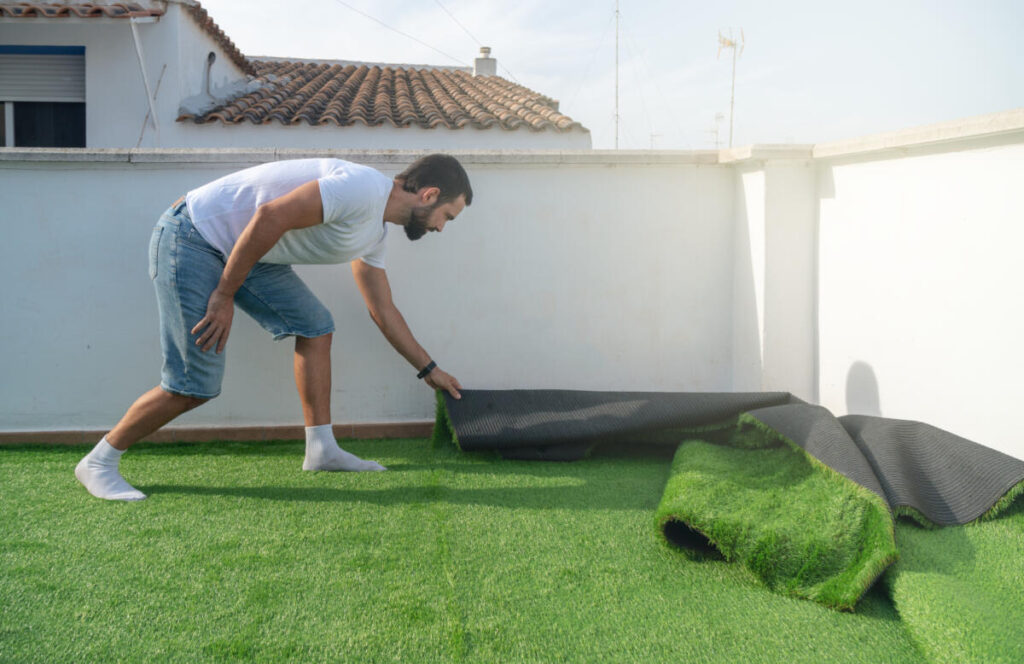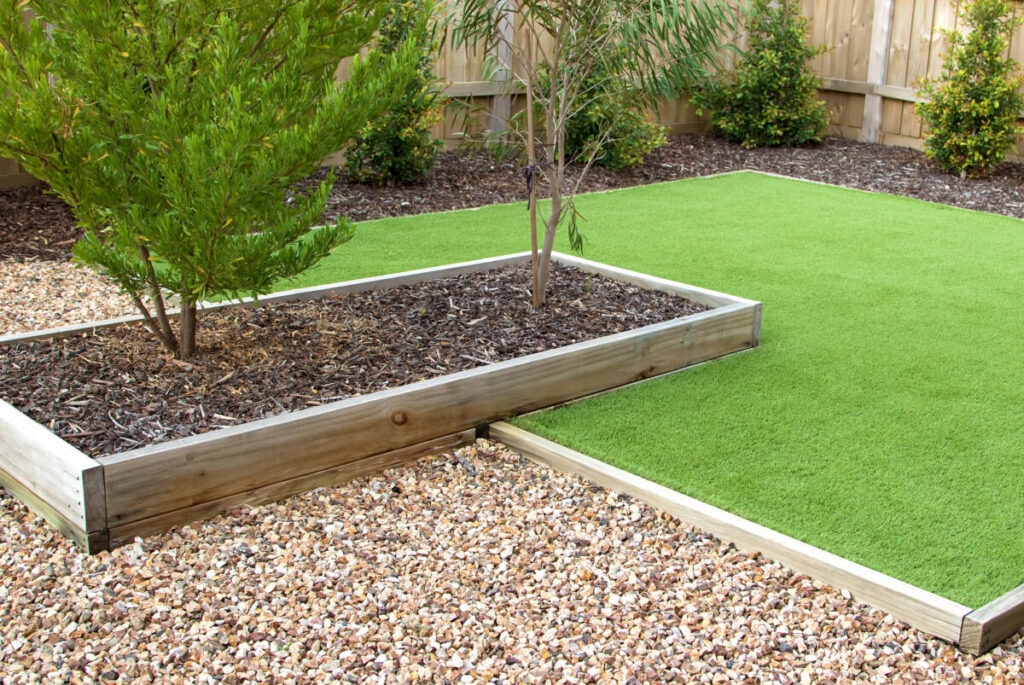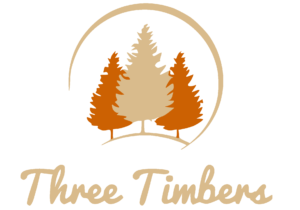Are you tired of spending endless hours maintaining your lawn? Then artificial grass may be the solution you’ve been looking for! But before you start digging up your current lawn, its important to understand the true cost of an artificial grass lawn.
In this blog post, we’ll break down the costs of artificial grass, which artificial grass you should choose, and installation.
Table of Contents
The Short Answer to “How Much Does Artificial Grass Costs”
- Artificial grass with installation costs between $16 and $20 per square foot.
- The average installation cost of mid-grade artificial grass costs between $6,500 and $9,500.
- Material cost of artificial grass can range between $2.00 for low end Polypropylene and $8.00 for higher end Nylon.
Understanding the Cost of Artificial Grass
Artificial grass has become increasingly popular among homeowners who want to save time and money on lawn care. How much does it cost to install artificial grass?
As you probably expected, it can vary depending on the size of your project and the type of artificial grass chosen. You also need to consider the materials, labor, and installation expenses involved. On average, homeowners typically spend between $5,000 to $7,000 for a 500 sq ft artificial grass yard.
Understanding the various factors influencing the cost of artificial grass installation is key. Factors like leveling the yard, the quality of turf, and the yard’s shape can all impact the overall cost.
Material Costs
Material costs for artificial grass depend on the type and quality of the product. Prices vary significantly, with artificial grass costs ranging from $2 to $8 per square foot. If you prefer higher quality materials, with extended durability, and realism, you can expect to pay more.
Labor Costs
Labor costs for installing artificial grass usually range from around $3 to $9 per square foot, depending on the complexity of the project. Several factors influence the cost of labor, such as the type of synthetic turf, the size of the area, and the amount of prep work required.
Keep in mind, many yards require leveling before installation which may add to labor costs.
Installation Expenses
Installation expenses for artificial grass include:
- Site prep
- Base materials (crushed rock or decomposed granite)
- Weed barriers
- Debris removal & disposal
A weed barrier is a material that stops weeds from sprouting through the artificial turf. It can cost between $0.40 and $0.80 per square foot. Appropriate site preparation like leveling and debris removal (old landscaping, large rocks, etc.), is often necessary to prevent any repairs in the future.

Choosing the Right Artificial Grass for Your Needs
Choosing the appropriate artificial grass for your needs is vital to maximize your investment. Factors such as durability, appearance, and intended use will all influence your choice of artificial grass material. The three main types of artificial grass are nylon, polypropylene, and polyethylene. Each material has its own unique features and qualities that might be better suited for different places or needs.
Understanding the advantages and disadvantages of each material, as well as the specific requirements of your intended use, can help you make the best decision for your artificial grass installation. Let’s dive deeper into these factors.
Durability
Durability is an important consideration when choosing artificial grass. Nylon is the most durable option but also the most expensive. It’s made from a strong type of plastic fiber and can handle heavy foot traffic, making it ideal for high-traffic areas. The grass blades stand up taller and straighter, so it’s more resilient and lasts longer.
Investing in a durable artificial grass can save you money on long-term maintenance and repairs. Top brands for durable artificial grass include:
- SYNLawn
- XGrass
- EasyTurf
- Mega Grass
- Astro Turf
- ForeverLawn
- Global Syn-Turf
- Shaw Sports Turf
- RealGrass
Blade Shapes and Realism of Artificial Grass
Artificial grass is offered in a variety of different blade shapes that play a substantial role in the overall appearance of the turf. In general, the lower cost options feature basic flat blade shapes, while others mid to high tier products offer more complex and natural shapes. Different styles of artificial grass that can affect its appearance include:
- V-shaped
- U-shaped
- W-shaped
- C-shaped
- Flat blade
The color, thatch, pile height, and density of the grass can also be customized to give a unique look that matches the natural grass in your area.
Some specific brands and product lines known for their realistic appearance include:
When it comes to selecting your artificial grass, we typically recommend a more natural looking turf. While the lower price point can be tempting, the standard flat shape can look cheap and take away from the enjoyment. By choosing an artificial grass that closely resembles natural grass, you can truly enjoy the look and feel of your new yard.
Intended Use
The intended use of your artificial grass will influence the best choice of material. For example, different materials may be used for residential lawns, sports arenas, or commercial applications to ensure durability, stability, and aesthetic appeal.
For sports fields, nylon turf or crossflex turf are excellent choices, as they are strong and built to last.
For playgrounds or children’s areas, artificial grass with a fall height rating and high durability is best. SYN and Play Time offer great options such as:
- Play Time Playground Turf
- SYNAugustine X47
- SYNPlay
- SYNTipede 343
- SYNRye 200
DIY vs. Professional Installation

When it comes to installing artificial grass, homeowners must decide between DIY and professional installation. DIY installation can save on labor costs but may result in a less professional finish with clear transition lines, along with the risk of potential issues down the road. Professional installation ensures a high-quality result and often includes a warranty for added peace of mind.
DIY Installation Overview
DIY installation can save you on labor costs. However, installing artificial grass yourself can be moderately difficult and requires the right preparation, tools, and skills.
If you choose to handle the installation yourself, it’s important to follow to the installation instructions provided by the manufacturer and if you have questions, make sure to reach out. DIY installation can take anywhere from 8 to 30 hours of work, depending on your experience and the size of the project.
All in all, DIY artificial turf installation is possible, but generally not recommended unless you have the necessary tools and experience.
Professional Installation Overview
Professional artificial turf installation involves the following steps:
- Ground clearing
- Base preparation and leveling
- Artificial grass installation
- Infill
- Finishing touches
- Cleanup
The cost for professional installation typically ranges from $5.50 to $18.75 per square foot depending on the complexity of the project and quality of materials.
Choosing professional installation guarantees a high-quality outcome that will last for many years. Many artificial grass manufacturers also offer warranties when their product is installed by a professional, which can give you some added peace of mind. Most installers also offer a warranty on workmanship for the first year so you can rest easy knowing the installation was done right.
Maintenance Tips for Artificial Grass
Following appropriate maintenance practices is necessary to keep your artificial looking its best while avoiding repair costs. Here’s what you need to do to keep your artificial turf in excellent condition for the long term.
Regular Cleaning
Regular cleaning of artificial grass involves the following steps:
- Rake and rinse the grass with water to remove debris
- Use a push broom to brush the grass to keep fibers upright
- Use a power brush to further groom the grass and remove any stubborn dirt or stains
- Use an eco-friendly cleaner to wash any areas that require extra attention
It’s recommended to clean your artificial grass at least once a month, or more frequently if your yard gets a lot of use or is exposed to excessive dirt, dust, or debris.
Weed Control
Weed control is easy with your artificial grass. All installations should include weed barriers to keep the weeds at bay. Weed barriers, such as polypropylene fabric, non-woven fabric, and woven fabric, are great options to use with artificial grass.
While artificial turf is quite resilient to weeds, it’s a good practice to occasionally inspect your artificial lawn for early signs of weed growth and take appropriate action to prevent any issues from growing.
Repair and Replacement
Over time, repair and replacement of artificial grass may be necessary. The typical lifespan of artificial grass is between 10-25 years, depending on the quality and maintenance of the turf. Quickly addressing any damage, like tears or rips, will help extend the life of your artificial grass.
The Next Step to Installing a New Artificial Grass Yard
Artificial grass is an excellent choice for homeowners looking to save time and money on lawn care. If you’re thinking artificial grass is the right choice for you, give us a call at Three Timbers! Our team proudly offers expert artificial turf installation throughout Minnesota and Arizona.
Frequently Asked Questions
How long does artificial grass last for?
Artificial grass can last up to 20 years or more with proper installation, care and maintenance. High-quality turf and regular upkeep can extend its lifetime further, allowing you to enjoy your evergreen lawn for 15 to 20 years or more.
What goes under artificial grass?
A sub-base of mixed aggregates is installed beneath artificial grass to create a smooth, compacted surface and a solid foundation. The two main types of sub-base are crushed miscellaneous base (CMB) and decomposed granite (DG).
Can you lay artificial grass on soil?
You can lay artificial grass on soil, but you must prepare the subsurface first by clearing the surface and making sure it is level and well-drained. You should also remove existing grass, roots, mulch, pine needles or other obstacles that could impact the artificial grass over time. Laying artificial turf on top of natural grass is not recommended.
Is artificial grass safe for pets?
Yes, artificial grass is safe for pets and is actually easier to maintain than natural grass when it comes to pet waste.


